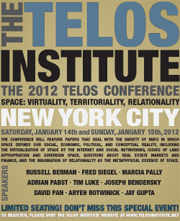This paper was presented at the 2012 Telos Conference, “Space: Virtuality, Territoriality, Relationality,” held on January 14–15, in New York City.
 It is almost impossible to consider architecture independently from space. Indeed, the definition of architecture should implicitly or explicitly include this concept. The first role of architecture is to create and manipulate space. Any architectural object is not only a contained element in space but also an element that participates in the orientation of space and therefore in the making of a place out of a space. Moreover, the architectural object makes space act within a performing stage and defines it as a closed or open space. There is no architecture or architectural action without space. The human use of space and values with which society imbues spatial relations signifies the ground of architecture.
It is almost impossible to consider architecture independently from space. Indeed, the definition of architecture should implicitly or explicitly include this concept. The first role of architecture is to create and manipulate space. Any architectural object is not only a contained element in space but also an element that participates in the orientation of space and therefore in the making of a place out of a space. Moreover, the architectural object makes space act within a performing stage and defines it as a closed or open space. There is no architecture or architectural action without space. The human use of space and values with which society imbues spatial relations signifies the ground of architecture.







